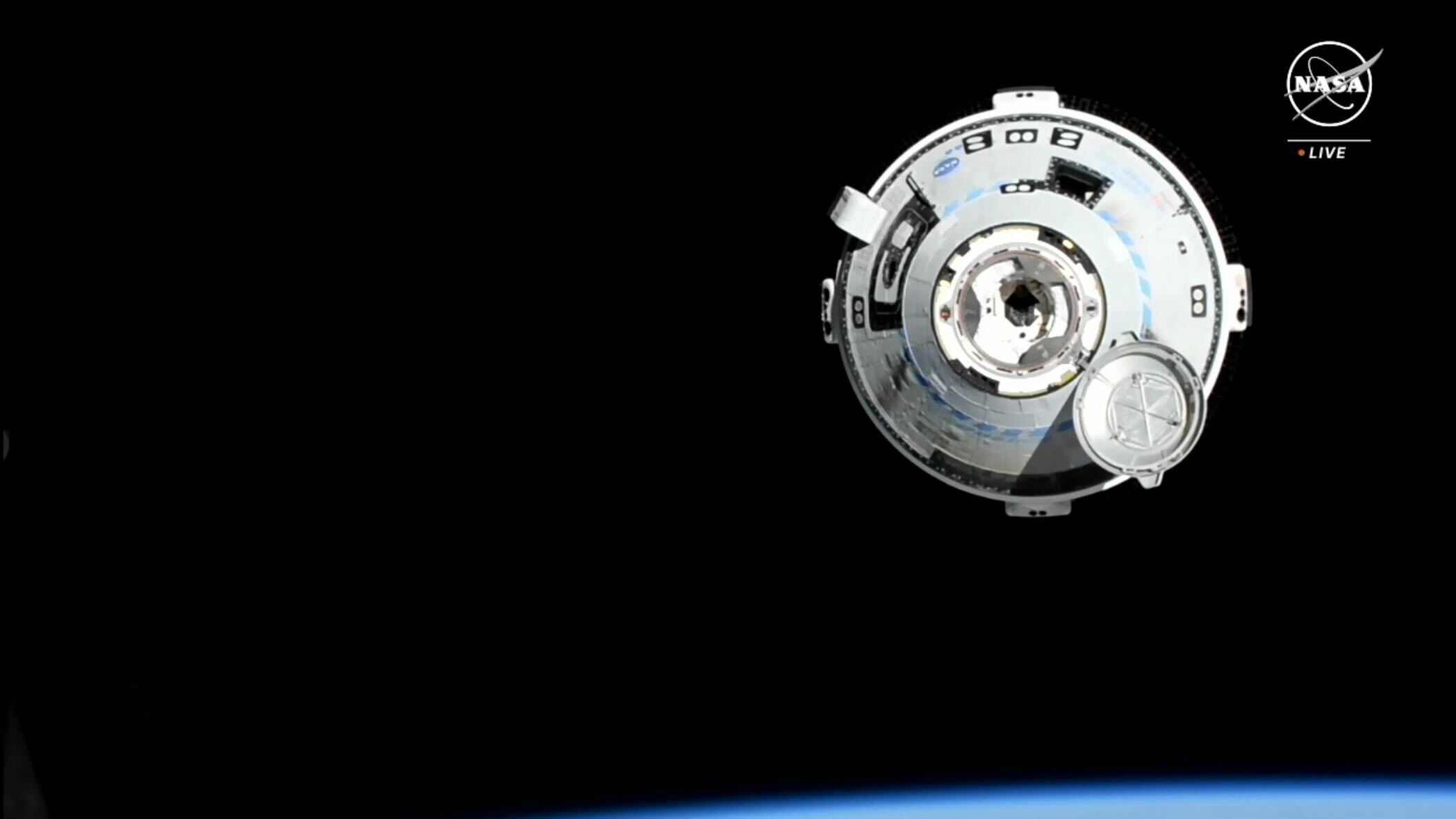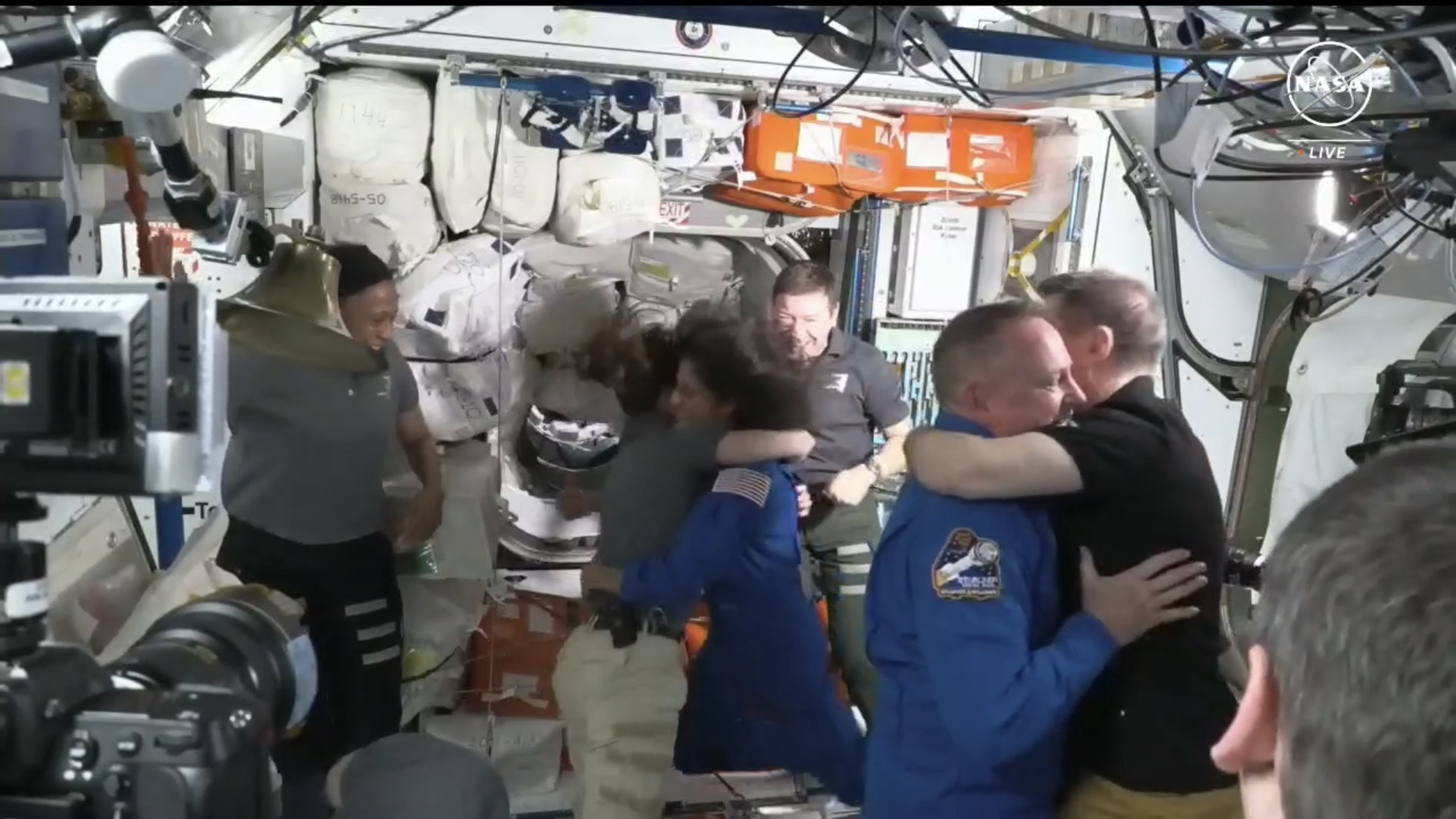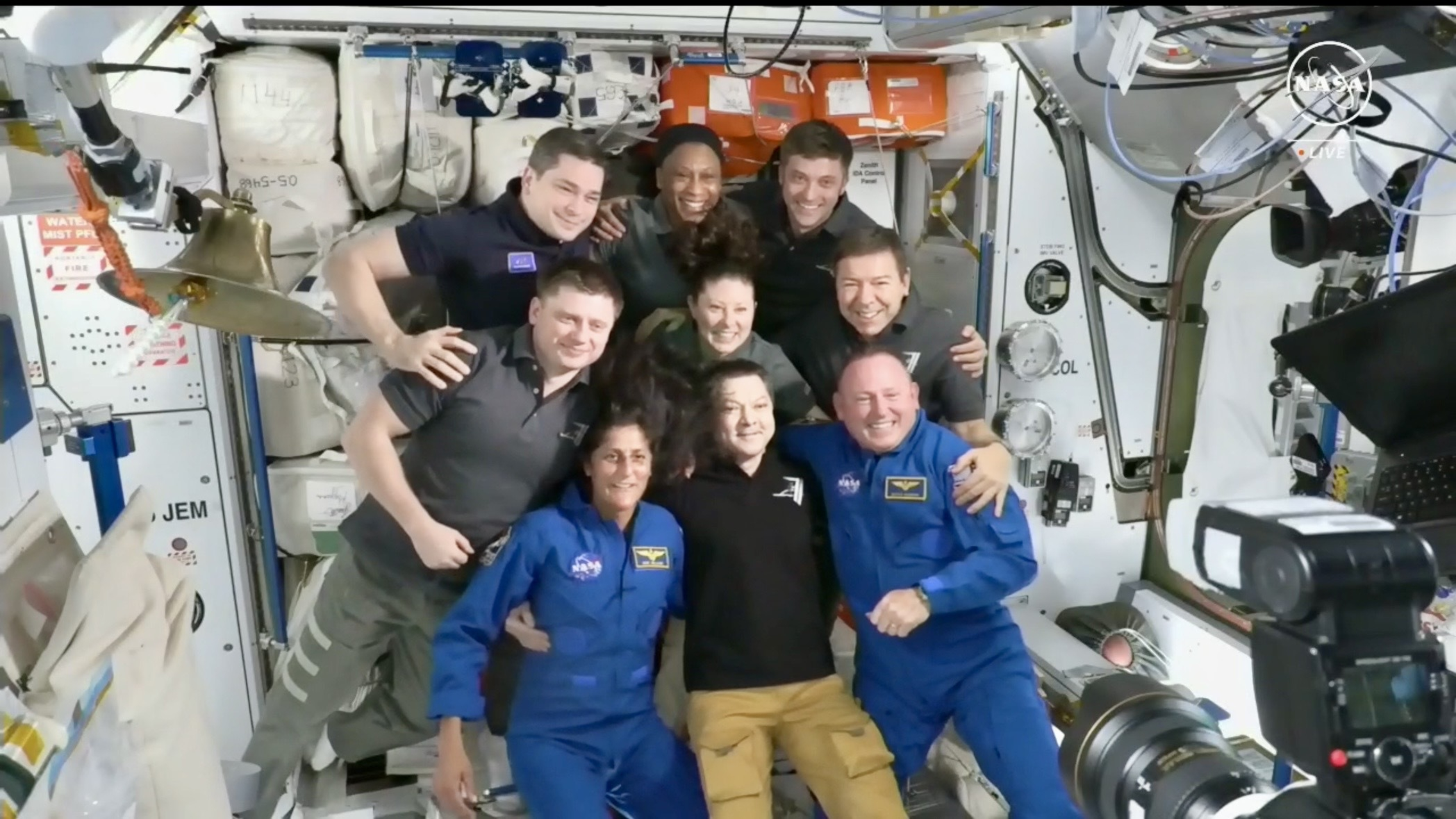Boeing's Starliner capsule has arrived at its orbital destination.
Starliner reached the International Space Station (ISS) today (June 6), making contact with the orbiting lab at 1:34 p.m. EDT (1734 GMT) as the duo flew over the southern Indian Ocean.
That was a bit later than originally planned. Starliner missed its first docking chance, at 12:15 p.m. EDT (1615 GMT), after five of its 28 reaction-control thrusters malfunctioned. But the mission team got four of those impacted thrusters back online, and Starliner was cleared to approach the ISS in the next window. (You can follow our Boeing Starliner live updates for the latest on the mission.)

Starliner launched Wednesday (June 5) on its first-ever astronaut mission, known as Crew Flight Test. CFT is sending NASA astronauts Butch Wilmore and Suni Williams to the ISS for a roughly week-long stay.
"Butch and Suni, nicely done," Neal Nagata, NASA's CAPCOM (spacecraft communicator) radioed the Starliner astronauts from Mission Control in Houston. "Welcome back to the ISS."
"Nice to be attached to the big city in the sky," Wilmore radioed to Mission Control. "It's a great place to be. We're looking forward to staying here for a couple of weeks and getting all the things that we need to get done."

About two hours after, Wilmore and Williams opened Starliner's hatch and entered the International Space Station and received a warm greeting by the seven members of the station's current Expedition 71 crew. They were welcomed by the ringing of a bell (an ISS tradition), music and zero gravity "dancing" as the pair floated around the Harmony module, hugging their new crewmates.
Get the Space.com Newsletter
Breaking space news, the latest updates on rocket launches, skywatching events and more!
"Wow, great to be back here," Wilmore said during a welcome ceremony. "Obviously, we certainly have been gone for a little while, but it's very familiar." Both Wilmore and Williams have flown to the space station before on previous missions.

"There's only one problem," Wilmore added as he turned to NASA astronaut Matt Dominick on the Expedition 71 crew. "Matt is in my crew quarters. I don't know what we're gonna do about that. But thank you all for the great welcome."
If all goes well with CFT, Starliner will be certified to fly long-duration astronaut missions to the orbiting lab for NASA.
Boeing received a $4.2 billion contract to do just this back in 2014. SpaceX got one as well, worth $2.6 billion. Elon Musk's company flew its version of CFT, known as Demo-2, in 2020 and is in the middle of its eighth operational crewed mission to the ISS.
Starliner's thruster issues today followed two helium leaks the mission team detected after the capsule reached orbit. A different helium leak cropped up before launch as well, but was not regarded as a serious problem.
Editor's note: This story was updated at 4:30 p.m. ET on June 6 to include comments of the Starliner astronaut crew after arriving at the ISS.
Join our Space Forums to keep talking space on the latest missions, night sky and more! And if you have a news tip, correction or comment, let us know at: community@space.com.

Michael Wall is a Senior Space Writer with Space.com and joined the team in 2010. He primarily covers exoplanets, spaceflight and military space, but has been known to dabble in the space art beat. His book about the search for alien life, "Out There," was published on Nov. 13, 2018. Before becoming a science writer, Michael worked as a herpetologist and wildlife biologist. He has a Ph.D. in evolutionary biology from the University of Sydney, Australia, a bachelor's degree from the University of Arizona, and a graduate certificate in science writing from the University of California, Santa Cruz. To find out what his latest project is, you can follow Michael on Twitter.
-
fj.torres Good grief.Reply
(As Charlie Brown would say.)
They trust this thing to land safely?
When is the next Dragon launch? -
Rob77 I wont be surprised if Starliner heads down with no passengers, Suni & Butch will just have to get the next Dragon taxi home.Reply -
DrRaviSharma I have posted here and on LinkedIn the fears I have for reviving such low progress rate missions where knowledge and its live practice gets rusted, lost or does fade away.Reply
This flight test attempt could have done a few things automated.
Now that we have one great risk remaining namely landing on LAND rather than Sea, we could have at least rehearsed that in automated robotic way before exposing Suni and Butch to that "First"?
Trusting Being on whose planes we fly all the time, for their backup strategies and retrieval of online intime management of split-second contingencies we have saved a robotic mission that could have reduced risks to these brave test pilots.
However there is SILVER LINING, most enjoyable is the video of Suni entering the ISS from Starliner - A Moment of Happiness as someone returns home after a long tiring journey as ISS has been her home.
It is reminding me of a fish being released back into waters where it can breath and live happily.
My best wishes to both Suni and Butch and especially for landing safe on the ground another first!
Thanks.
Ravi
(Dr. Ravi Sharma, Ph.D. USA)
NASA Apollo Achievement Award
ISRO Distinguished Service Awards
Former MTS NASA HQ MSEB Apollo
Former Scientific Secretary ISRO HQ
Ontolog Board of Trustees
Particle and Space Physics
Senior Enterprise Architect
SAE Fuel Cell Tech Committee voting member for 20 years.
http://www.linkedin.com/in/drravisharma -
Unclear Engineer Ravi, weren't the first 2 flights all robotic, and didn't they do the Soyuz type touchdown on land?Reply
Frankly, I think it is a good thing to have the pilot be able to take manual control of Boeing automated actions. Remember that Boeing designed an automated flight control system that crashed two 737s due to sensor problems. -
DrRaviSharma Unclear EngineerReply
Yes you are right. I stand corrected. There was one uncrewed therefore robotic mission called OFT2 with Calypso capsule that did not dock with ISS due to technical difficulties but did land on land successfully.
Frankly it has taken so long with gaps in this contract that any one like me lost track of what all has been attempted.
Thanks to NASA for transferring risks to its astronauts to cover gaps that Boeing should have reduced by more automated tests.
And now perhaps only smaller risk is there for crewed LAND Landing.
Best wishes to Suni and Butch for safe touchdown in California our home for last decade. :)
Thanks.
Ravi
(Dr. Ravi Sharma, Ph.D. USA)
NASA Apollo Achievement Award
ISRO Distinguished Service Awards
Former MTS NASA HQ MSEB Apollo
Former Scientific Secretary ISRO HQ
Ontolog Board of Trustees
Particle and Space Physics
Senior Enterprise Architect
SAE Fuel Cell Tech Committee voting member for 20 years.
http://www.linkedin.com/in/drravisharma









